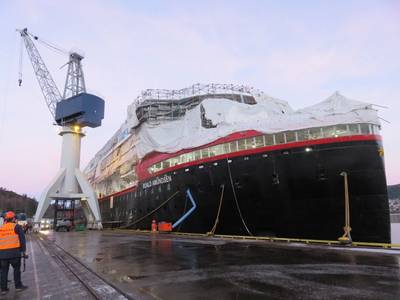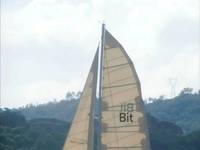Shipbuilding: Hurtigruten Hybrid Construction Forges Ahead

The first of Hurtigruten’s new hybrid powered expedition cruise vessels, the MS Roald Amundsen, under construction at the Kleven Yard in Ulsteinvik, Norway: delivery is expected in May 2019. (Photo: Tom Mulligan)
Norwegian company Hurtigruten, the world’s largest expedition cruise operator, is continuing to push the boundaries when it comes to green travel with its order for three hybrid-powered vessels nearing completion, the first ship being due for delivery in May 2019.
Two of these revolutionary ships are currently under construction at the Kleven Yard in Ulsteinvik, Norway, the MS Roald Amundsen and its sister ship, the MS Fritjof Nansen, both of which are custom-designed to cope with some of the most extreme conditions seen on our planet, each having a specially-designed, ice-strengthened hull. According to Hurtigruten CEO, Dan Skjeldam, these are the greenest, most advanced cruise ships the world has ever seen – “ships that will stand out.”
Among the new amenities to be featured on the vessels are substantially larger battery packs to make expedition voyages even more sustainable. This is in line with the company’s policy of investing heavily in green technology, the next step being to power its cruise vessels with liquefied biogas (LBG), a fossil-free renewable gas produced from dead fish and other organic waste. “What others see as a problem, we see as a resource and a solution,” said Skjeldam. “By introducing biogas as fuel for cruise ships, Hurtigruten will be the first cruise company to power ships with fossil-free fuel.”
Renewable biogas is considered to be the most eco-friendly fuel currently available and is already used in other modes of transportation, especially in buses. Northern Europe and, in particular, Norway, which has large fishery and forestry industries producing a steady supply of organic waste material, has a major opportunity to become a world leader in biogas production and Hurtigruten plans to operate at least six of its ships using biogas and batteries, combined with liquefied natural gas (LNG) by 2021.
Hurtigruten offers voyages to more than 200 destinations in more than 30 countries from the Arctic to Antarctica throughout the waters of Norway, Greenland, Svalbard, Iceland, Europe, South America, Central America, North America and Arctic Canada.




